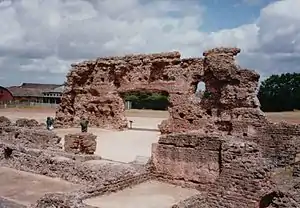Venta Icenorum
Venta Icenorum (Classical Latin: [ˈwɛnta ɪkeːˈnoːrũː],[1] literally "marketplace of the Iceni")[2] was the civitas[3] or capital of the Iceni tribe, located at modern-day Caistor St Edmund in the English county of Norfolk. The Iceni inhabited the flatlands and marshes of that county and are famous for having revolted against Roman rule under their queen Boudica in the winter of AD 61.


Roman town
The town itself was probably laid out, and its first streets metalled, in approximately the first half of the second century.[4] The town, which is mentioned in both the Ravenna Cosmography and the Antonine Itinerary,[5] was a settlement near the village of Caistor St. Edmund, some 5 miles (8.0 km) south of present-day Norwich, and a mile or two from the Bronze Age henge at Arminghall. The site lies on the River Tas.
Archaeology
In 1928, an aerial reconnaissance flight of a farm near Caistor St Edmund rediscovered the ruins of Venta Icenorum. A five-year archaeological dig soon followed, led by archaeologist Donald Atkinson.[6]
The site subsequently remained uninvestigated until the University of Nottingham reopened it in 2009 seeking Iron Age (Iceni) structures beneath the town. The evidence uncovered revealed that the site was not established on a previous Iron Age town, but was a newly built and sparsely populated frontier town focused on administration and trade.[7] It also revealed a partial integration of the mainly agrarian locals into Roman norms.
The embankments of Venta Icenorum can still be seen at Caistor today. The ruins (grid reference TG230034) are in the care of The Norfolk Archaeological Trust and managed by South Norfolk District Council. In 2011, the Trust expanded the site by buying an additional 55 acres of land across the river opposite the West Gate.[2]
See also
References
- Probably meaning "central place of the Iceni", cf. Matasović, Ranko, Etymological dictionary of Proto-Celtic, Brill, 2009, p. 413. The old idea that Venta was a Latin term used in Britain for "market town" has long been rejected by all place-name scholars (A. L. F. Rivet & C. Smith, The place-names of Roman Britain, p.262-5; R. Coates, Remarks on 'pre-English' in England: with special reference to *uentā, *ciltā and *cunāco, Journal of the English Place-Name Society 16 (1983-4) 1-7; T. S. Ó Máille Venta, Gwenta, Finn, Guen, Nomina XI (1987), 145-152).
- "Caistor Roman Town | Norfolk Archaeological Trust". www.norfarchtrust.org.uk. Retrieved 10 April 2019.
- Ptolemy, Geography 2.2
- The Urban Plan of Venta Icenorum and its Relationship with the Boudican Revolt. William Bowden. Britannia / Volume 44 / , pp. 145-169. Published by The Society for the Promotion of Roman Studies. doi:10.1017/S0068113X13000184. Published online: April 2013. "it is much more likely that the earliest metalled streets were laid out at some point in the second century, probably during its first half. We know that at least one of the main streets of the grid (the North-West Street) was not formalised until the late second century at the earliest and so it can reasonably be argued that the street plan developed more gradually. Consequently the earliest lay-out of the town was smaller than that covered by the streets at their greatest extent." http://journals.cambridge.org/action/displayFulltext?type=6&fid=9038691&jid=BRI&volumeId=44&issueId=-1&aid=9038690 accessed 19 November 2013.
- "Roman Britain".
- "Donald-Atkinson-(1886-1963)-(Biography) - Norfolk Heritage Explorer". www.heritage.norfolk.gov.uk. Retrieved 10 April 2019.
- Angelo Crist (22 October 2017), Time Team Special 45 (2011) - Boudica's Lost Tribe, archived from the original on 21 December 2021, retrieved 10 April 2019
Bibliography
- Peterson, John W. M. (2003). "Iron Age and Roman square enclosures near Venta Icenorum : Roman changes in a prehistoric ritual landscape". Collection de l'Institut des Sciences et Techniques de l'Antiquité. Besançon (France). 890 (1): 161–184.
External links
- http://www.livescience.com/history/071217-roman-town.html LiveScience - New Details of Ancient Roman Town Uncovered
